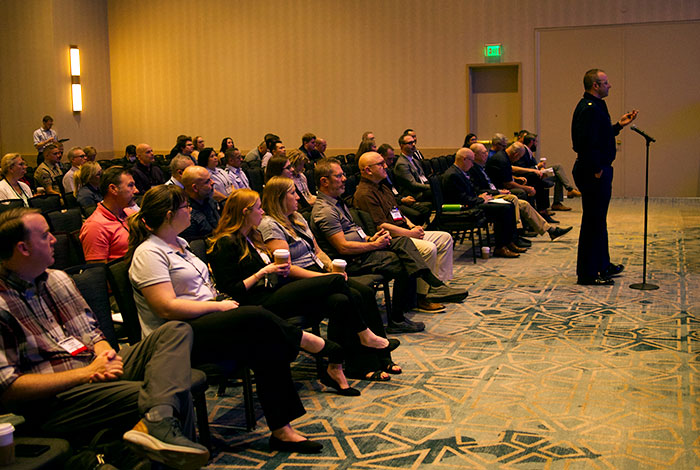Researcher Uses Historical Data to Identify Trends in Pilot Injuries

KISSIMMEE, Fla. — The protective equipment currently provided to Army rotary-wing aircraft crews is effective at protecting against injuries caused by enemy ordnance, though unprotected arms and legs remain the most vulnerable to injury, according to an analysis of combat damage events that occurred during Operations Enduring Freedom and Iraqi Freedom between 2003 and 2014.
Frederick Brozoski, an engineer at the U.S. Army Medical Research and Development Command's Aeromedical Research Laboratory at Fort Novosel, Alabama, discussed the findings of his research into the outcomes of enemy attacks on UH-60, AH-64 and CH-47 helicopters during OEF and OIF during a panel session at the 2024 Medical Health System Research Symposium in Kissimmee, Florida Aug. 28.
"The good news is that the protective systems built into the aircraft as well as the personal protective equipment worn by the occupants were very effective in preventing injuries," said Brozoski. "Roughly 70% of the personnel involved in those combat damage events were uninjured."
According to Brozoski's analysis, the extremities consistently received the largest proportion of injuries from enemy ordnance, followed by the face, head and neck, with thorax and abdomen experiencing the least injury. The most common type of injury was penetration from bullets and shrapnel, unlike ground forces which experienced more explosive concussion injuries, he noted.
"What these data show is the regions without armor receive the highest frequency of injury," Brozoski explained. "If you think about it, the extremities and the face are typically left unprotected, whereas the thorax, the abdomen and the head typically have body armor to protect them. Furthermore, many aircrew seats also provide additional thoracic and abdominal protection."
Brozoski worked with MRDC's Joint Trauma Analysis and Prevention of Injury in Combat center at Fort Detrick to analyze the data and identify patterns and trends in aircrew injuries. JTAPIC coordinates a unique multiservice partnership of subject matter experts in intelligence, medicine, operations and materiel to provide rapid-turnaround analysis of complex data on incidents and accidents involving deployed Warfighters. The military services use JTAPIC's analyses to improve equipment, tactics, techniques and procedures in theater as well as in the acquisition process.
The analysis also looked at proportional injury trends in ground forces during both operations, as well as at similar data from World War II and the Korean and Vietnam wars for comparison.

Brozoski noted that the data set had some limitations. For example, it did not include instances where PPE and aircraft protective systems prevented injury, which makes extrapolating the true risk of injury difficult. Nevertheless, the data suggest that additional protection for extremities might be warranted, pointing to a potential avenue of future research.
"We saw no systematic deficiencies in current protective equipment provided to Army rotary-wing occupants," said Brozoski.
USAARL specializes in delivering scientific solutions that save lives and maximize the performance of aviators as well as airborne and ground Warfighters through partnerships with government, academic, nonprofit and industry organizations across the U.S. It operates groups that specialize in warfighter performance, en-route care, injury biomechanics and protection and research platforms.
The annual four-day MHSRS conference is the DOD's premier medical science research and development meeting. Over 4,000 people representing the military, academia, private industry and international partners attended the event to learn about the latest advances and initiatives in health care research related to combat casualty care, military operational medicine, clinical rehabilitation, information science, infectious diseases and radiation health effects. Many military and civilian representatives from across MRDC participated in the symposium as panelists and presenters.
Dr. John Crowley, USAARL's science program director and co-moderator of the panel session, titled "Current Challenges in DOD Aerospace Medicine," noted that aerospace medicine has not featured prominently at MHSRS in the past, but thanks to cutting-edge research like Brozoski's, interest is growing.
"It's important to look at the unique performance aspects associated with aviation occupations as well as the environmental stresses involved," Crowley said. "Human performance in an abnormal environment such as flight makes for a broad assortment of research issues."














